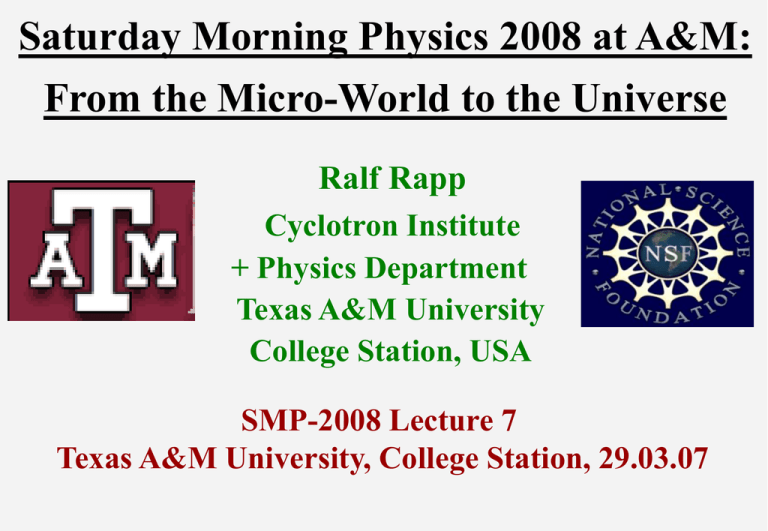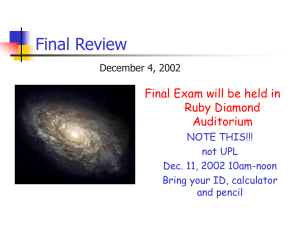Saturday Morning Physics 2008 at A&M: Ralf Rapp Cyclotron Institute
advertisement

Saturday Morning Physics 2008 at A&M: From the Micro-World to the Universe Ralf Rapp Cyclotron Institute + Physics Department Texas A&M University College Station, USA SMP-2008 Lecture 7 Texas A&M University, College Station, 29.03.07 Outline 1.) Overall Structure of SMP08 Lectures 2.) From Particles+Forces to the Universe Force Properties and Proton Structure The Role of Fundamental Forces in the Cosmos 3.) Gravity and Dark Matter 4.) Weak Force and Universality 5.) Nucleosynthesis, Stars and the Universe’s Fate Supernovae: Nuclear Burning + Expansion of the Universe Neutron Stars 6.) Concluding Remarks 1.) From the Smallest to the Largest 20th (and 21st ?!) century: tremendous progress in our understanding of elementary particles + their interactions Also true for the origin and evolution of the Universe Intimate relations between the subatomic and the cosmic world unraveled early example (17th century): Newton discovered the connection between the falling apple and planetary motion (universality of gravity!) SMP2008 was an attempt to illuminate some of these fascinating discoveries in Nuclear/Particle/Astrophysics (and exhibit open problems …) 1.2 Topical Structure of SMP08 The Weak Force: Dancing to its Own Tune J. Hardy Descent into the Proton: A Journey inside an Elementary Particle R. Fries Dark Particle Hunters T. Kamon SMP ’08 Presentations Neutron Stars: Giant Atomic Nuclei in the Sky H. van Hees Determining the Ultimate Fate of the Universe via Supernovae K. Krisciunas Alchemy of the Universe: Nucleosynthesis of Chemical Elements A. Banu 2.) Known Particles + Forces in the Universe • “Standard Model of Particle Physics” • based on symmetry principles: matter particles interact via force carriers • stable matter: u , d , e- , ne • 2 more “generations” (heavier + short-lived) • bare masses: mu,d = 5 MeV … mt = 175 GeV • forces differ by - exchange particles - charge content - range - strength 2.2 Fundamental Force Properties Sun • Gravity (graviton exchange) m1m2 - static force law (Newton): FG ( r ) -GN 2 G r - extremely small coupling Earth but only one charge long range! • Electromagnetism (photon exchange) eq1q2 aem - static force law (Coulomb): FG ( r ) GC ~ 2 2 aem ≈0.01 r r - small coupling, 1 anti-/charge e medium range e• Weak Force (W-,Z-boson exchange) a - static force law (Fermi,GSW): Fw ( r ) ~ w2 exp[-mW r ] ± W r - small coupling, 2 anti-/charges n - massive carriers extremely short range u • Strong Force (gluon exchange) - static force law (QCD): Fs ( r ) ~ -a s / r 2 - aS ≈ 1 g - large coupl., 3 anti-/charges, short range, confinement! d g 2.3 Proton Structure • Deep-Inelastic Electron Scattering Structure Functions xf(x) CTEQ Parton Momentum Fraction x • Spin Structure of the Proton Sq S g quark spin gluon spin 1 Lq Lg 2 gluon orbital angular momentum quark orbital angular momentum - quark- and gluon-spin contribution small - quark orbital angular momentum?! 2.4 The Role of Particles + Forces in the Evolution + Structure of the Universe • Gravity (long range) - large scale structure (galaxies, galaxy clusters) - star formation and collapse, black holes • Electromagnetism (medium range) - neutralization of electrons/nuclei 400,000y after Big Bang - cosmic microwave background TUniverse=2.73oK - g-ray bursters (the largest fire crackers in the Universe) • Weak Force (very short range) - generation of bare masses 10-11s after Big Bang - star cooling (neutrinos), element transmutation (p↔n) • Strong Force (short range) - generation of visible mass 10-6s after Big Bang - star burning and explosion, neutron-star structure Nuclear Physics and the Universe Quark-Gluon Plasma: T>200MeV (<0.000001 sec.) Phase transition to Hadronic Matter (Mass Generation, Quark Confinement), T≈170MeV (0.00001 sec.) Low-mass nuclei: H (p), d (pn), 3He, 4He, 7Li (3 min.) Heavy elements in star collapses: supernovae (still today) Exotic forms of (quark) matter in neutron stars (still today) 3.) Gravitational Force and Dark Matter • Evidence for Dark Matter • Supersymmetry?! (Neutralino!) 3.1 Dark Matter Evidence and Properties Cosmic collision of 2 galaxy clusters: DM unaffected! 1 2 3 4 time Dark Matter Properties: - very weakly interacting, charge-neutral - slowly moving (“cold”), stable+heavy particle no such particle in the Standard Model, new idea needed! Supersymmetry: • fermion↔boson partners for all standard-model particles • Supersymmetry “broken”: mstand << msuper ~ 1TeV/c2 g ne n n e Neutralino ~0 1 ~20 Dark Matter Candidate! 3.2 How to Measure Dark Matter in the Lab? • proton-proton collisions at the highest energy (14TeV): Large Hadron Collider (LHC) at CERN: 4.) Precision b-Decay: Testing the Weak Force Recall: around ~1700 Sir Isaac Newton realized the universality of gravity Is the Weak Force universal, too? Use precision measurements of nuclear beta-decay to check 5.) Nucleo-Synthesis, Stars + the Universe • Nuclear Burning • Supernovae - White-Dwarf Explosions (type-Ia) - Heavy-Star Explosions (type-II) • Fate of the Universe • Neutron Stars 5.1 Nuclear Burning • Principle: large energy gain if light nuclei “fuse”: A + B → C + binding energy EB= [ (MA+MB)-MC ] c2 • “problem”: Coulomb repulsion between A and B • A and B need to “touch” to feel strong force and bind • large temperature and density required for nuclear fusion (burning)! • Big Bang: rapid expansion, only up to mass A=7 (Li), gaps at A=5,8! • much later: gravity-driven star formation - Sun (M~M☼) p+p→ d +p→3He +3He→4He+2p - heavy stars: 34He →12C +4He→16O +16O→4He+28Si +28Si→56Co→56Fe - star collapse and explosion: all elements beyond A=56 (no energy gain) 5.2 Star Evolution Chart Hydrogen cloud Gravity ignites 2H burning Mstar< 8 Msun Burning up to 4He Mstar > 8 Msun Burning up to iron Single star: Red giant Companion star: Accretion on white dwarf Gravitational core collapse White dwarf cools forever White dwarf reignites 4He burning Type-II Supernova explosion Nova Explosion Type-Ia Supernova Complete obliteration Neutron star or Black Hole 5.3 SN-Ia Candles + Expansion of the Universe • accurate light output I0, intensity I(r) =I0/4pr2 precise distance r(I) • Doppler (red-) shift of spectral lines recession velocity, vr , of source Intensity vs. Redshift [Krisciunas Velcocity et al. 2004] vs. Distance [Hubble 1929] Accelerating Universe Dark Energy!! 5.4 Type II Supernovae • High-mass star (Mstar> 8M☼), • burns fast (~50 My), up to 56Fe core collapse type-II supernova explosion • produces all known heavy elements • leaves behind moving+rotating NS/BH • MNS ≈ 1.4 M☼ , but R=15km • up to 5-10 times density of nuclei!! • study cold nuclear equation of state (quark plasma, color-superconductor …) • rotation: lighthouse (mag. field), glitches • g-ray emission (bursters?) • general relativity (grav. waves?) 6.) Some Perspectives for You If you Enjoy / are excited by Physics / Science Tend to be curious Like to try things out AND/OR like math, computers then we recommend to: Watch out for future SMP Series at A&M (2+ more) Consider enrolling in the Physics Undergraduate Program at A&M Inform yourself about future career paths in Physics 6.2 Thanks to: You! (students) Our high school teachers! Our lecturers: Profs. John Hardy, Teruki Kamon, Kevin Krisciunas, Hendrik van Hees, Rainer Fries, Dr. Adriana Banu The staff support team: Kendra Beasley, Shana Hutchins, Bruce Hyman, Leslie Spikes, Sharon Jeske, Tony Ramirez, Jerry Deason The SMP organizing team: Hendrik van Hees, Xingbo Zhao, Trent Strong, Saskia Mioduszewski, Rainer Fries + Adriana Banu Financial Support: U.S. National Science Foundation, Texas A&M Cyclotron Institute + Physics Department 2.1 Hot+Dense QCD Matter in Nature Early Universe (few s after Big Bang) Phase Diagram Compact Stellar Objects (Neutron Stars) | | In the laboratory: high-energy collisions of heavy nuclei! Objective: to create matter at temperatures T > Tc ≈ 170MeV and energy densities e > ec ≈ 1GeVfm-3 3.1 Evidence for Dark Matter I • motion of stars within galaxies: there must be more matter than we “see” (emits light) Dark Matter: - “background”? - new particles? 5.3 Novae and Type-Ia Supernovae • White dwarf accretes matter from red-giant companion (binary system) (i) helium burning ignited on surface Nova explosion (ii) mass accretion up to 1.4 M☼ Type-Ia Supernova explosion, extremely regular light output:





